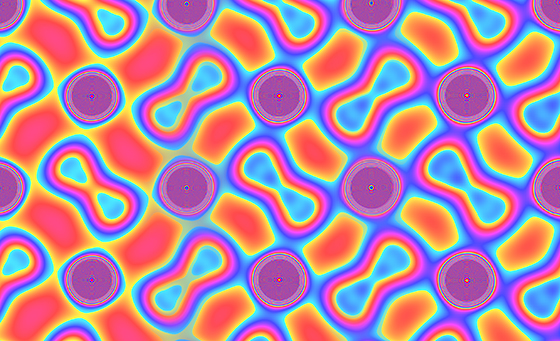|
|
|
|
 As a compound of manganese sulfide is compressed in a diamond anvil cell, it undergoes dramatic transitions. In this illustration, the interaction between the manganese (Mn) atomic ions (purple circles) and disulfur (S2) molecular ions (figure 8s) increases from left to right until the overlap is significant enough to make the system metallic. (Illustration courtesy of Dean Smith, Argonne National Lab)
Under pressure, 'squishy' compound undergoes remarkable transitionsRemarkable things happen when a “squishy” compound of manganese and sulfide (MnS2) is compressed in a diamond anvil, say researchers from the University of Rochester and the University of Nevada, Las Vegas (UNLV).
“This is a new type of charge transfer mechanism, and so from a science community point of view this is very, very exciting. We are showing remarkable physical transformations over a very, very short range of parameters, in this case pressure,” says Ashkan Salamat, associate professor of physics at UNLV.
For example, as the pressure increases, MnS2, a soft insulator, transitions into a metallic state and then into an insulator again, the researchers describe in a paper flagged as an editor’s choice in Physical Review Letters.
“Metals usually remain metals; it is highly unlikely that they can then be changed back to an insulator,” says Ranga Dias, assistant professor of mechanical engineering and of physics and astronomy at Rochester. “The fact that this material goes from an insulator to a metal and back to an insulator is very rare.”
Moreover, the transitions are accompanied by unprecedented decreases in resistance and volume across an extremely narrow range of pressure change—all occurring at about 80 degrees Fahrenheit. The relatively low temperature enhances the chances that the metal transition process might eventually be harnessed for technology, Salamat says. Read more.
New leader for Office of Clinical ResearchAfter a 10-month search, the Office of Clinical Research (OCR) welcomes Nicole Mason as its new director as of August 1.
OCR, which is housed within the University’s Clinical and Translational Science Institute (UR CTSI), supports the administration of clinical research across the University of Rochester Medical Center.
“I’m excited to welcome Nicole on board to lead the OCR and its strategically important projects,” says Martin Zand, a co-director of the UR CTSI as well as the senior associate dean for clinical research at URMC. “Her extensive and varied professional background in clinical care and research makes her an outstanding leader for OCR to connect with and serve the full clinical research community.”
Mason joins the OCR from the University’s Office of Human Subject Protection, where she has served as the executive director of the Research Subjects Review Board for the past two years and as a regulatory specialist for the preceding eight years. In those roles she worked closely with researchers to shepherd their IRB submissions and conducted regulatory reviews of human subject research studies. Read more.
Study identifies cues for growing blood vessels Using single cell RNA-sequencing, Eric Small, associate professor in the Aab Cardiovascular Research Institute, identifies vascular guidepost cells that provide instructive cues for growing blood vessels to follow in a study reported in Nature Communications.
The ultimate goal of the research is to develop strategies that will improve repair or regeneration after a heart attack.
The study was led by first author Pearl Quijada, a postdoctoral fellow in Small’s lab who is now starting her own lab at UCLA.
Read the full study here.
This year's KL2 Career Development AwardeesThe University’s Clinical and Translational Science Institute (UR CTSI) annually provides two-year KL2 Career Development Awards for early-stage researchers. With the guidance of a mentor team, KL2 scholars develop research projects that set the stage for further K- or R-award applications.
This year’s awardees are:
- Ian Cero, a postdoctoral fellow in psychiatry, will adapt a previously validated network health intervention, called Wingman-Connect, to help adolescents who are hospitalized for a suicide attempt better regulate their emotions and engage support-guidance relationships.
- Daniel Lachant, assistant professor of pulmonary diseases and critical care, hopes to supplement or supplant current diagnostics for pulmonary arterial hypertension with a new measure: cardiac effort (the number of heart beats required for a person to walk a given distance).
- Nicole Wilson, assistant professor of pediatric surgery, pediatrics, and biomedical engineering, will use a novel computer vision-based software to calculate the length of a patient’s small intestine, develop a 3D model of intestinal structure, and investigate the properties of the intestinal tissue as a tool to make it easier to assess patients’ intestinal health.
Read more.
Biomedical Data Science Hackathon is Aug. 17-22Undergraduates, graduate students, and postdocs are invited to participate in an online University of Rochester Biomedical Data Science Hackathon Aug. 17-22 that will test their ability to make predictions from high dimensional data.
University students and trainees at any skill level can work individually or in teams of up to four people. Prizes will be given for better than random predictions, and cash prizes will be awarded for first and second place.
Register here by noon, Aug. 16. Questions can be directed to: andrew_mcdavid@urmc.rochester.edu, matthew_mccall@urmc.rochester.edu, or alarracu@bio.rochester.edu.
This event is sponsored by University of Rochester Goergen Institute for Data Science Working Group in Life Sciences and Biomedical Data Science and the
National Science Foundation.
|
|
|
|
|